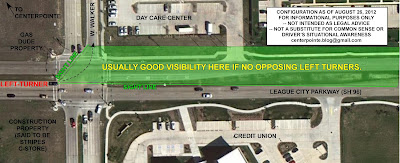I've now seen this kind of near-miss happen so many times that, yesterday, I had to come home and actually draw up that intersection in graphics software just to prove to myself that the situation really is as bad as my common-sense street-level eyeballs are suggesting.
Upon drawing it, I concluded that it's actually worse.
But before I get to that, the standard disclaimers apply. The key phrase in all of this is common sense. I'm not a traffic engineer or mobility expert. But what I see happening at West Walker and League City Parkway needs to be addressed and I'm using my non-expert common sense to offer my personal viewpoints here. But don't rely on what I'm saying - what you need to do is use your common sense to determine how this issue could potentially affect you.
Most of us welcomed the recent switch to the adaptive traffic signals that allow left turns on yellow arrows in some League City intersections. After those signals got changed over, I observed most drivers being very cautious in making their elective left turns, as they got accustomed to the new system.
But fast forward a few months and a bit of complacency seems to have set in. What I'm now seeing is more drivers being quite assertive when they elect to turn left on a yellow arrow.
The potential problem with this, especially at West Walker and League City Parkway, is that the sight lines are very unfavorable when a driver faces opposing left turners - and this is almost always the case due to the heavy traffic at that particular intersection.
Let's look at this step by step.
Here is a screengrab of that intersection with notable features labeled:
 |
| Click on it to enlarge. Base screengrab courtesy of Googlemaps. |
 |
| Click on it to enlarge. Base screengrab courtesy of Googlemaps. |
 |
| And the size of that blind spot is not limited to what is drawn here. It extends considerably further east. Click on it to enlarge. Base screengrab courtesy of Googlemaps. |
 |
| Do you see where either of the two west-bound dashed arrows intersect the left-turn arrow? Those are the potential crash points. Click on it to enlarge. Base screengrab courtesy of Googlemaps. |
- The blind spot created by opposing left-turners is HUGE.
- The mistake I see many drivers making is that they underestimate the size of that blind spot, especially now that everyone has more self-confidence in the new flashing-yellow-arrow system.
- Drivers know there's a blind spot, so what many of them tend to do is simply wait on the flashing yellow for a few seconds for the blind spot to clear.
- They then take their left turn.
- The problem is that because some of them underestimate the size of the blind spot to start with, they don't wait long enough. Just as they are executing their left turn, oncoming westbound (WB) traffic is finally emerging from the blind spot.
- That oncoming WB traffic is traveling at 45 mph. If a left-turning driver screws this up, they run a significant risk of getting broadsided because there won't necessarily be enough time for them to get out of the way, and there won't be time for oncoming traffic to halt or take evasive action, because of the speeds involved.
Myself, I've gotten totally out of the habit of attempting this left turn if there are any opposing left-turners stopped in their lane. I simply judge that I cannot safely do it because of the size of that blind spot. My refusal to budge does tend to p*ss off some aspiring yellow-light left-turners who may be in the left-turn lane behind me, but I do not care. Attempting that turn without adequate visibility is not worth a risk to anyone's life.

No comments:
Post a Comment
I'm forced to moderate comments because the spammers have become too much for me to keep up with. If you have a legitimate comment, I will post it promptly. Sorry for the inconvenience.